Arctic Landscapes – What to Expect on an Expedition to the Far North
The wildlife may hog all the attention on expeditions to the far north but the Arctic landscapes soon reveal themselves to be the most magical of surprises.
No-one expects to be completely overawed by the Arctic landscapes. Everyone thinks the only time their heart will skip a beat is when they see a polar bear or walrus, close up. Yet the seemingly endless multi-hued horizons of our planet’s far north are spectacles to behold, the jaw-dropping tundra, speckled by snow, ice and wildflowers in Summer, making you feel as if you’ve just landed on another planet. Coupled with jagged icebergs, some of the world’s largest fjords, glaciers, and snow-blanketed mountains that seem to tickle the sky, the Arctic offers perhaps the most magnificent wilderness scenes on our planet.
Sometimes, you just don’t know where to look…
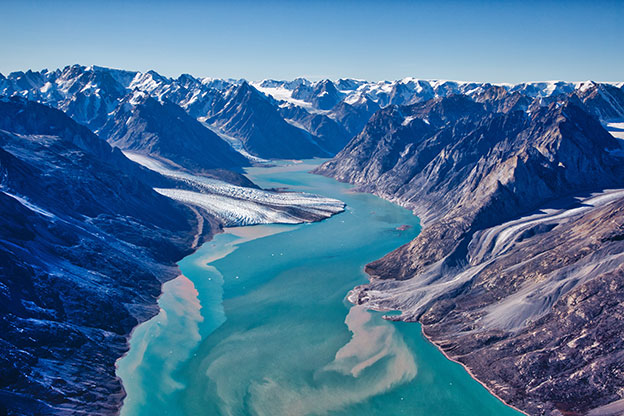
What makes Arctic landscapes so special?
Take a polar expedition to the Arctic and you’ll soon realize that your notion of ‘ice, snow and more ice’ is not matched by the reality of the Far North, in Summer. Unlike Antarctica, the Arctic boasts trees, vegetation and rolling green hills covered in wildflowers, albeit for a very short period of time every year. Yet regardless of how short this explosion of flora may be, it is what enables the hardy wildlife to thrive here, all year long, and what provides visitors with a kaleidoscope of scenes. Don’t be mistaken: nothing about this region is ‘lush’. The Arctic is just as dramatic and barren as Antarctica, with plenty of packed ice and ice-floes, the further north you roam. Yet there’s no denying that the Arctic is milder and much kinder to humans, which is the reason humans have inhabited the region for thousands of years. It’s also the reason why close-up the two polar regions may appear identical but, from afar, they are nothing alike.
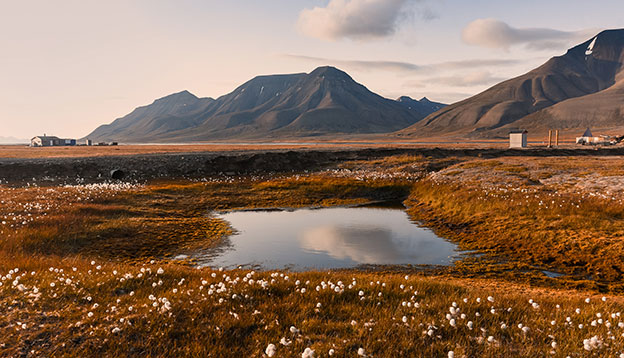
The highlights of the Arctic landscapes
Here are just a few of the Arctic landscape highlights you can feast your eyes on and where you should head to for that once-in-a-lifetime wilderness banquet:
Icebergs in the Arctic
Given the milder climate, the Arctic boasts smaller icebergs when compared to Antarctica although you’d never know it at first glance. They’re still very impressive in the north, most especially if these are the first icebergs you’ve ever seen. The warmer temps also mean that modest though they may be, the Arctic icebergs can be much more jagged and irregular in shape than their southern counterpart (where they can appear as gargantuan ice-skyscrapers).
Where to see them – The majority of the icebergs in the Arctic originate from the Greenland Ice Sheet which is the reason the deep fjords of Greenland and the sea passages between Greenland and Svalbard (north) or Iceland (east) are the best Arctic cruise destinations if seeing icebergs is your top priority. You’ll also want to choose an early departure date as the bergs are obviously bigger and more dramatic right at the start of cruising season (June).
Iceberg obsessed? Find out more, right here


Arctic Glaciers
There seems to be an urgency to seeing Arctic glaciers, nowadays, the doom-and-gloom media reporting on their swift melt on an almost-daily basis. Whilst the Arctic isn’t going to melt just yet, there’s no denying the situation is at a critical crossroad and the world’s glaciers are certainly melting and calving at an unprecedented rate. Glaciers make up about 0.5% of the world’s land surface and about 70% of our planet’s freshwater supply, with the Arctic claiming about 45% of that.
Where to see them – The aptly-named Glacier Bay National Park in Alaska is perhaps the best place to see Arctic Glaciers, although cruises to this UNESCO-listed treasure are restricted. On the other hand, you have the easier-to-reach glacial splendours in Iceland, Greenland and the Svalbard archipelago.
Iceland’s most famous delight is Snæfellsjökull, a towering glacier-topped volcano on the far west peninsula, as well as Vatnajokull, one of Europe’s largest glaciers. Over in Greenland, you’ll be spoilt for choice when it comes to glaciers, with at least half a dozen on the eastern side (visit on cruises from Svalbard or Iceland) and four major ones on the west coast (visit on cruises from Canada) – the most astonishing and famous of all is UNESCO-listed Ilulissat, considered the world’s fastest-moving glacier. As for Svalbard, well, given that over 60% of the archipelago is covered in ice, you’ll be ecstatic to know that here lie over 2,000 distinct glaciers of all sides. You could seriously have an absolute ice-field-day on a circumnavigation of Svalbard.
Nuts about glaciers? See how they’re tracked, mapped and counted, right here
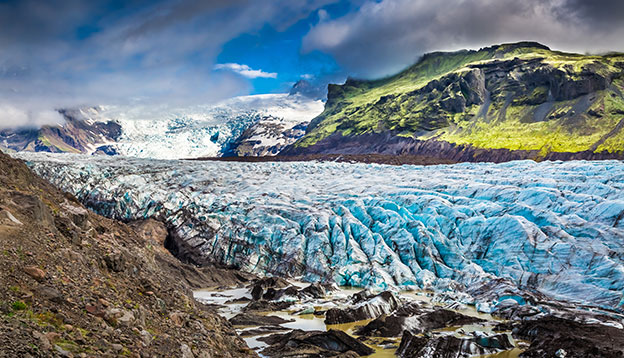
The Arctic Tundra
One of the world’s most inhospitable yet fascinating, biomes, the Arctic tundra is a treeless plain that stretches from the North Pole all the way south to the taiga, the coniferous Arctic forest, and is defined by its extremely cold temperatures and almost complete lack of rainfall. Imagine a high-altitude mountain range above the treeline, so barren and harsh? This is a tundra, although in the Arctic it isn’t the altitude that makes it barren, but the latitude. Although seemingly lifeless, the tundra is actually teeming with low-lying bushes and shrubs in the short Summer (for about 60 days a year), sustaining a countless array of tough animals like the Arctic fox, grey wolf, musk oxen, polar bear and caribou. This far north, the tundra is covered in permafrost which keeps tree roots from taking hold. Although the consequences of global warming are mainly highlighted with the melting of glaciers, the deterioration of the Arctic tundra, and its entire ecosystem, is of pivotal importance right now. More so because the permafrost is currently trapping about 14% of the earth’s carbon: the more the permafrost melts, the more carbon is released, and the more it melts yet again.
Where to see it – Anytime you take an Arctic cruise expedition, you’ll be in the heart of the tundra, with the biome stretching south to cover the northernmost regions of the European, Asian and American mainlands.
Discover how climate change is revealing Arctic landscapes hidden for 40,000 years
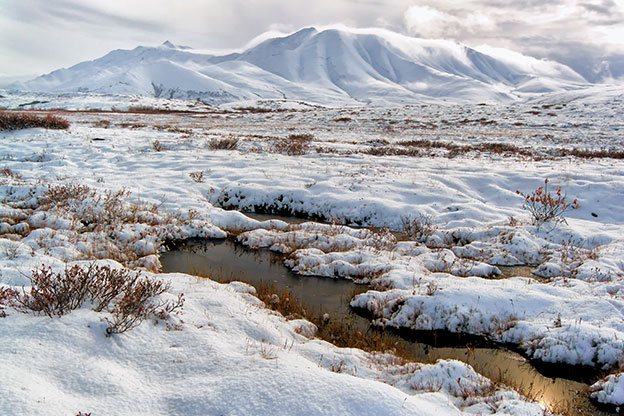
The Arctic Taiga
The ethereal boreal forests of the Arctic, the taiga, are nestled between the tundra in the north (at about 70-degree-north) and temperate forests about 10 degrees below the Arctic Circle. Considered the world’s largest single land-based biome, the taiga (the Russian word for ‘forest’) is characterised by its dense pine, lurch, birch and spruce trees, compacted together as if trying to make up for their stark absence in the north. The kind of trees you’ll find in the Arctic taiga is determined by where in the region you explore. This in-between forest feeds a multitude of wildlife and people, the most famous resident being the Siberian tiger which lives in the Russian taiga. Given that Arctic expedition ships depart well within the Arctic Circle, you’ll likely just be flying over the taiga.
Where to see it – If you’d wanted to include a visit to this incredible forest winter wonderland, you can add a side-trip to Prince Edward Island in Canada or, alternatively, plan an unforgettable husky-sled adventure in northern Norway and Finland which are run in some of the most pristine taiga forests of all.
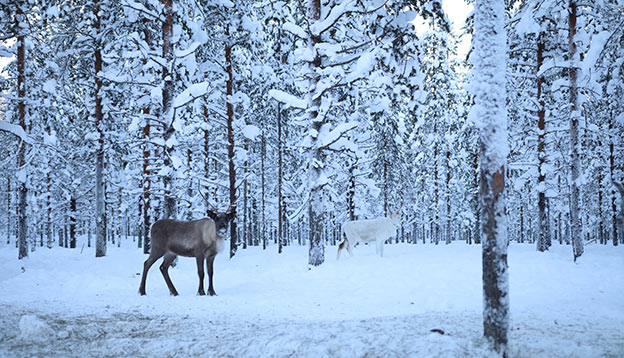
The Arctic Mountains
The northernmost mountains in the world are an ethereal frame to the Arctic’s most haunting landscapes and you’ll be able to soak up the stunning scene no matter where in the Arctic you travel.
Where to see them – In Svalbard, they stand tall and proud, sculpted as if by magic. They are undoubtedly the first landscape highlight that sing to your soul from the moment you alight your plane in Longyearbyen. Take an expedition in Canada and you’ll come face to face with the Arctic Cordillera, a long and narrow mountain range that separates famed Baffin Island from the western side of Greenland, encompassing almost 200,000 square kilometres with the highest, Barbeau Peak, rising up just over 2,600m in altitude. Famous Mt Whistler is the second-highest mountain in the North American range. The mountains on Greenland’s eastern side are perhaps the most impressive, boasting heights well over 3,300m, and the northern part of Russia’s Ural Mountains the most remote. No matter which Arctic expedition you choose, you will feast your eyes on a wide array of high, snow-drenched peaks – so much so that mountaineering excursions are offered by many expedition ships in the north.

Arctic Fjords
If there’s one landscape highlight everyone’s itching to see on Arctic expeditions it would have to be the region’s most magnificent fjords. In this regard, you can almost choose an expedition blindfolded although where would the fun be in that? The most famous, celebrated and breath-taking fjords are in Iceland, Greenland and the Svalbard archipelago, the latter almost a continuation of the most famous sub-arctic fjords of the western Norwegian coastline. Aside from being drop-dead-gorgeous inlets, fjords also boast calmer and shallower waters and that makes them enticing to whales and other marine life which, in turn, makes them unparalleled wildlife-watching destinations.
Where to see them – On Spitsbergen’s northern coast is where you’ll find Raudfjorden, where ringed and spotted seals head to in Summer, followed closely (or rather stalked) by polar bears. On the northeast is Liefdefjorden, one of the most arresting of all the fjords in the Arctic because it runs parallel to the 5km-long Monaco Glacier and, in the southwest, is where a maze of fjords spring from the 20km-long Bellsund, an area revered for it high mountains, concentration of bird life and amazing historical highlights.

Not to be outdone, small and unassuming Iceland boasts no-less than 109 fjords, the most famous on the west (the cleverly-named Westfjords) yet plenty on the east as well. Iceland has the added bonus of exceptional infrastructure, which means you can land ashore and take hiking or mountain biking excursions to take in the sights from every angle. Plus, there are always those soul-reviving waterfalls…



Across the western channel, instead, is the one place that boasts the least amount of infrastructure. Greenland is so pristine and scarcely populated that it doesn’t even boast a big enough port to act as a base for Arctic expeditions yet it’s precisely this kind of out-of-this-world wilderness that makes it so appealing. The fjords on the eastern coast are the most dramatic, inlets so vast and framed by snow-capped peaks so high that they dwarf even the most formidable ice-strengthened ship. This is the kind of grandiose Arctic landscape that makes you feel utterly insignificant. The insanely deep Kaiser Franz Josef Fjord leads you almost 100km inland, among towering red-rock mountains, cascading glaciers and floating icebergs. Yet nothing compares to the largest fjord system on earth, Scoresby Sound, just to the south of Kaiser Franz Josef. The combined fjords in the Scoresby system cover a mind-boggling 38,000 square kilometres, more than you could ever cruise in a lifetime, or two.
The most mesmerizing aspect of Arctic landscapes is that they may not be the most considered highlight before an expedition but they soon become among the most adored memories. In one of the world’s most astonishing regions, Mother Nature reigns supreme in every which way imaginable. For once-in-a-lifetime expeditions to the Arctic, be it to Spitsbergen, Iceland and Greenland, Canada or Russia and the North Pole, trust our polar travel specialists here at Chimu to help you find the right adventure for you.
Contact us to know more.
